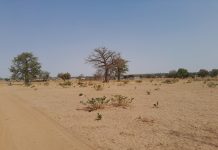With Madiba Singhateh
Rainfall was a good omen as it brought plenty of water which made plants grow and provide income to farmers and food for the population. That seems to be no more. As we get deep into the 2023 rainy season, last year’s victims in Tobacco Road, Jabang are wondering what is in stock for them.
In fact, right from the start, disaster had struck Wuli West, destroying houses and properties in Sutukonding, Taibatu and Kolibantang, where 10 households became homeless and continue to be homeless till today. There is a lot of talk of preparedness, but the reality on the ground does not show any serious sign of preparedness if the example of Kolibantang is to go by.
What are the facts on the ground?
There was heavy downpour of rain on 15th June and homes and properties were destroyed. A team from the NDMA regional office went to the three villages on the following day, did an assessment and told the villagers that they will share their findings with their partners, meaning that they will seek financial and material support from their partners like the UN system, the Red Cross and others.
Up till today, ten households in Kolibantang remain homeless and are facing extreme hardship. Forty nine households in all are affected by the disaster.
Unlike the NDMA, the Red Cross showed some level of preparedness by providing blankets, mats and sanitary materials such as buckets, bleach, soap, toothpaste and other items from their store in Basse on the day after the assessment.
It is now getting to two months since the disaster and homeless victims had to spend the night under a tree when it does not rain or squeeze into the alkalo’s overcrowded houses when it rains. Getting accommodation for them is a matter of urgency. Getting prepared for a disaster which will lead to homelessness means planning ahead to accommodate such victims within a day.
After waiting for nearly two months, the victims are to receive something today. Foroyaa will be there to monitor developments and report accordingly.
Flood is now becoming the order of the day, destroying properties and displacing families. Last year alone, 50,378 were affected and 7404 were displaced which was devastating.
We caught with Mr Sana Dahaba from the NDMA and Mr Alasan Senghore from Red Cross.
According to Mr Dahaba, prior to the rainy season, the NDMA governing Council summoned a meeting with the purpose of strengthening the level of preparedness since they have received the weather forecast report for July, August and September. As a result, the governing council allocated some funds to strengthen the preparedness prior to the rainy season.
PARADIGM SHIFT
He said in Jabang the government is investing a lot since it is a hotspot area in terms of flooding and takes it as a priority to strengthen the level of preparedness and mitigate flooding.
“A lot of engineering work is currently been done at Jabang and we hope Jabang will not experience any flood, this effort is all geared to strengthen preparedness and mitigation.
“Over the years, the government has been providing response to victims but recently there are Paradigm shifts, instead of response, government is now strengthening mitigation, this is why a lot of work is been done at Jabang,” he said.
Speaking further, the director said in addition to Jabang, government has allocated some funds in cleaning 2000 metres drains in Brikama Njambai and also dredge some parts of the community to facilitate easy flow of water into the stream.
According to the director, the 1700 metres Ebo Town canal is already been cleaned completely, Bakau 1000 metres and also Jeshwang which is currently been drained by the NDMA excavators along Sankung Sillah highway.
Speaking on mitigation of area of hotspot especially in rural areas, especially Basse, the director said as of now, the contractors are mobilising for Basse another hotspot.
“If you look at thé Basse Jiroba Samba Tako, as of now, the contractors have been mobilised in addition to Sami Suruwa Kunda and Mbabppa Mandika, work has started in the areas and surrounding which are hotspots that flood every year.
He said in any disaster situation, government is the primary duty bearer. This is why the government is coming up with permanent engineering solutions to this problem.
In relating Climate Change and disasters, Mr Dahaba said Climate Change is real and Climate weather inductive disaster is actually impacting the lives and livelihoods of the population.
“We also have human inductive disaster, but naturally Climate inductive disasters are Common. This why government should do everything and invest in Adaptation measures so that we reduce the impact of Climate Change.
“As much as government is investing heavily on disaster management issues, people must also Change their Attitude.”
On his part, the Secretary General of Red Cross, Mr Alasan Senghore, said they deal with disaster preparedness and response including floods and windstorms.
“And, in short, in disaster preparedness, you always look at the concept of the country, what disaster the country is going through and here in this context, every rainy season we have flooding and windstorms”.
Mr Senghore said that they should focus on prevention which they do and that he thinks prevention is two-fold.
This first part is the software where people prevent themselves, then mitigate the effects of the disasters.
And the second part is very difficult because is the hardware where government and other institutions are involved such as drainages, roads and waterways.
“We in our part, we deal with the software because our volunteers are part of those communities so we continue the education of the communities in terms of preventive measures and so on.
Now our preparedness starts when the last disaster ends like last year, we had flooding and windstorms and when we finish responding, we did what we call lessons learned, we evaluate our performance. How did we perform? Did we deliver the right assistance? Was it timely? Was it efficient? He said.
CHALLENGES
“Our main challenges are we want to close the gap between when the disaster strikes and when the people receive assistance.
You know that it is important if relief comes and when it is late three to four days after then you see relief.
You need relief when disaster strikes because you are out in the open. You need a blanket, roof over your head and you need things to eat , clothing and shoes.
Over the years we have been covering the gap it started with number of days, if there is disaster caused by flooding, it takes almost two to three days before we mobilize, and in the last two years, we covered the gap. When the last floods in Banjul happened, just few hours, we were on the ground with something, we even evacuated families from their homes, so we closed that gap to few hours,” he said.
He said this year they managed to close the gap further in the sense that, in URR when the rains happened from midnight to 8am, by 9am their volunteers were with some stuff at the ground because their warehouse is full of stock as they are in partnership with UNICEF, UNFPA, International Red Cross Belgian, Red Cross and WASH Water Sanitation and Hygiene.
Mr. Senghore in conclusion said because of Climate Change, the frequency of disaster and flooding is so rapid to the extent that sometimes you find it difficult to get adequate resources to deal with all the challenges and that is why they are talking about solidarity so that people can lift those people from those vulnerable areas.






















